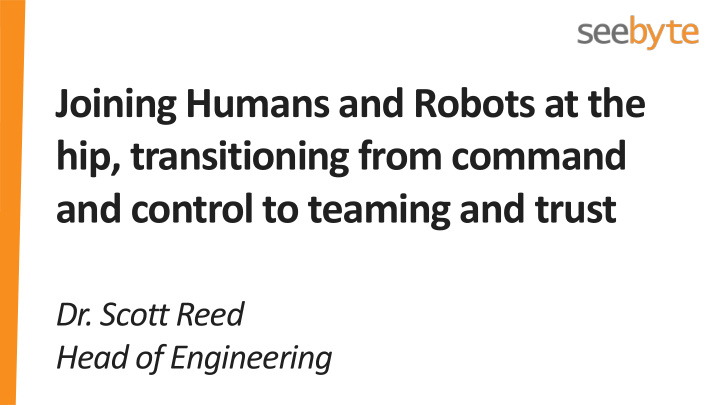



Joining Humans and Robots at the hip, transitioning from command and control to teaming and trust Dr. Scott Reed Head of Engineering
The 5 Year Vision 1. Can you survey the 1 sq. km area immediately outside the harbour? 3. I see the ATR has picked up a 2. Deck checks contact. Send complete, on my me a snippet for way. ETA 2 hours. verification 4. ATR Snippet sent. Reminder: can you get maintenance to check to my rudder?
Human-Machine Teaming Problems to Overcome Mental Model : The user’s belief on what a system can do will strongly impact whether they use it, trust it and determine how they use it Trustworthy Robotics: • Communications: What is the system doing? • Transparency: How does it work and why is it doing it? • Involvement: The user must feel in control Dependability and Predictability are key for trust
Transitioning to effective HMI Mission Level Autonomy Multi-modal interaction Command and Control Effective Human- of Unmanned Assets Machine Interaction On-board Reasoning Smart Communications End-user engagement
SeeByte Mission Level Autonomy 2003 Level 1: Navigate 2009 Level 2: Adaptive 2014 Level 3: Distributed 2016 Level 4: Multidomain now Level 5: Variable
Why use different modalities?
Multi-modal Interaction (click image for video) Prof. H. Hastie, Dr D. Robb, J. Chiyah
Example Interactions Starting survey OpArea0. Start the All previous objectives mission! completed. OK. Proceed On my way How long until mission completion? Abort objective. Vehicle SN224 taking over. I am not receiving any updates from side-scan 55 minutes sonar
Integrating AR into Interactions Can AR remove the water problem?
Participating with AR Compass – heading Map Field of view Location Vehicle information Objectives Vehicle path (click image for video) Vehicle to objective
On-board Reasoning • Richer levels of on-board classification allow autonomous decision making and autonomy explainability Clutter Flat Ripple Rock Cone Cylinder Sphere Wedge
Smart Communications 20 bytes / packet Transmission 4096 bytes 200 packets Reconstruction Original (JPG compression) 5 bytes 8192 bytes 10 bytes 20 bytes 1 packet 25 bytes (semantic compression) 50 bytes MODEL ORIGINAL DATA 70 bytes 3 packets 100 bytes 200 bytes 10 packets
End User Engagement • On-going, iterative engagement with the end-user is vital to ensure the autonomy technology adds capability • The User Experience is key – the technology must be simple, intuitive and add value • Technology must be delivered that can operate within SOP’s Tracking of eyes can stop / start PMA
Summary Current autonomy operations focus principally on planning after which operators are “autonomy observers” Transitioning to effective Human-Machine Autonomy requires: • Mission Level Autonomy allowing dynamic re-tasking and re-planning • Multi-modal interactions • Improved on-board perception to allow explainability • Smart communications to leverage available bandwidth and prioritise data sharing • Continual end-user interaction
Recommend
More recommend